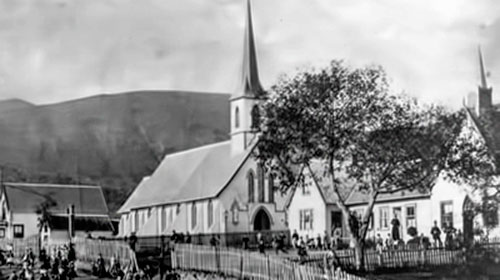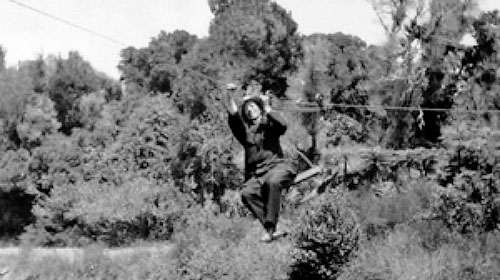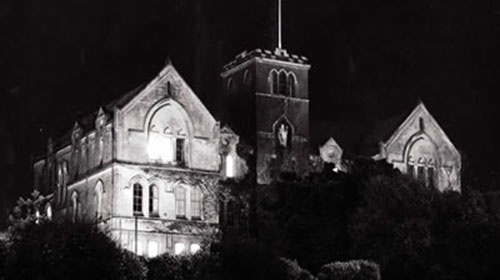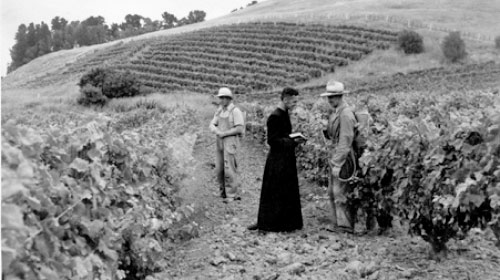The Society of Mary (sometimes known as the Marist Fathers) [SM] was founded by Father Jean Claude Colin in Lyon France in 1836 and Pope Gregory XVI commissioned them to bring Catholicism to the Western Pacific.
As they were the first Catholic missionaries to arrive in New Zealand, the early history of the Society in New Zealand is inextricably entwined with the arrival of Catholicism.
The Society of Mary comprises ordained priests and professed brothers, and is not to be confused with the Marist teaching brothers (FMS) founded by a Marist Priest, Saint Marcellin Champagnat SM.
The Marist brothers are a separate congregation which arrived later to teach in primary and secondary schools throughout New Zealand.
Pompallier and the early Marists
Protestant missionaries were already established in what Rome called the “Vicariate of Western Oceania”.
Bishop Jean-Baptiste Pompallier as Vicar Apostolic of Western Oceania, and the first group of Marists set out on the Delphine in 1836 as the first Catholic missionaries. Fr Pierre Bataillon and Br Joseph-Xavier Luzy were set down at Wallis, Fr Peter Chanel (later to become a saint,) and Br Marie-Nizier Delorme stayed at Futuna; on the way, Claude Bret died during the voyage.
Fr Catherin Servant and Br Michel Colombon were the first Marists to arrive in New Zealand with Pompallier in early 1838, where they had to learn Māori and English quickly.
Arriving in the Hokianga, they soon moved to the Bay of Islands. In all, 37 members of the Society of Mary arrived in New Zealand between 1838 and 1843.
Pompallier was not a Marist but had intended to become one. However, he was unable to, as he was appointed a bishop to the Vicariate.
In total, 37 members of the Society of Mary arrived in New Zealand between 1838 and 1843.
Two Marists had set out for Wellington in 1842 but they were lost at sea on the East Coast.
A lone Capuchin priest, Fr Jeremiah O’Reily, who had arrived in Wellington in 1843 as personal chaplain to the Fitzgerald family, saw his office widen to attend to the needs of the Catholics among New Zealand Company migrants.
In 1844 Pompallier appointed Fr Jean-Baptiste Comte to Wellington to look after the French at Akaroa, and Māori. A mission to Māori was started in Otaki.
Akaroa, which had seen the first Marists in 1840, and remains today New Zealand’s only French settlement, was a difficult mission. Fr Comte, Fr Jean Tripe and Br Florentin Françon returned north after becoming frustrated in 1842. Fr Antoine Séon, Br Euloge Chabany and Fr Jean-Simon Bernard did not last much longer when sent there in 1850.
The Wellington Diocese
Over time, however, differences over authority developed between Pompallier and Fr Jean-Claude Colin, the Superior General of the Society.
In 1848 the Vatican formally divided the country into two dioceses, Auckland where Bishop Pompallier would remain, and Wellington where the Marists would be based under Bishop Philippe Viard.
The Diocese of Wellington comprised the southern half of the North Island and all the South Island.
The Marists moved south into the Diocese of Wellington in 1850 and again implanted the Church in local areas. By the mid-1850s, the church was established in Nelson, Whanganui, Wellington, the Hutt Valley and Hawkes Bay. Periodic visits were made to the South Island, the Manawatu, Taranaki and the Wairarapa.
St Mary’s Church and Fr Garin’s Nelson School, 1864

Francis Redwood, the son of English immigrants, was one of Garin and Bertrand’s first pupils at what became a famous school in Nelson. Recognising his talent Redwood was sent by Garin and his parents in 1854 to study in Lyon and later Ireland.
When Viard died, Redwood succeeded him as second Bishop of Wellington.
Viard sent newly arrived Fr Jean-Baptiste Chataigner to Christchurch in 1860 and within a year Fr Claude Chervier joined him. Other missions fanned out over the Canterbury plains and finally a mission that was to last in Akaroa was established. In 1869 Fr Chataigner moved south to Timaru and thus the South Canterbury mission was begun.
While Viard had sent some itinerant diocesan priests to the West Coast area, they mostly got into strife so in 1868 he replaced them with Fr Aimé Martin and later additional Marists.
On his one and only ad limina visit to Rome, Viard asked for his territory to be divided. So in 1869 Bishop Patrick Moran was translated from the Vicariate Apostolic of Cape of Good Hope, Eastern District in South Africa to be the first Bishop of the Diocese of Dunedin, which covers Otago and
Southland. Fr Delphin Moreau had been the first resident missionary there.
Between 1857 and 1878, 24 French Marists and 12 Irish Marists came to the New Zealand mission.
Gradually Marists from England and Ireland became more numerous in the 1880s and 1890s.
In 1887, the Vatican further divided the Diocese of Wellington, carving Canterbury and the West Coast of the South Island into the new Diocese of Christchurch. The first bishop was John Grimes (an English Marist).
At the same time Redwood became an Archbishop and Wellington, the Archdiocese. Thus, the two central dioceses were Marist-oriented and the northern and southern dioceses, Auckland and Dunedin, were under diocesan bishops.
In 1889 New Zealand was erected as a Province of the Society of Mary and Fr Jean Leterrier arrived to be the first provincial. By that time, as well as establishing the church for Māori and settlers, Marists were involved in many different works: Formation of new recruits, Education, Retreats and Mission preaching.
The Mission among Māori

In The Marist presence in New Zealand was initially a mission to Māori. With the increasing arrival of European settlers and soldiers (many of whom were Irish Catholics), the priests started to minister to the spiritual needs of Europeans.
In some places, particular Marists carried on the mission among Māori often against great odds; some being particularly successful.
However, there was a general belief that Māori were dying out. After pleading with the Marist authorities by Suzanne Aubert, the founder of the Daughters of Our Lady of Compassion, further Marists arrived from France specifically to minister to Māori from 1879 until the early 1900s.
Redwood and, later, Archbishop Thomas O’Shea were somewhat limited in their support for the mission among Māori.
From 1918, New Zealand-born Marists became involved in the Māori Mission, with its name changing to Māori Pastoral Care in 1980s. The first Catholic Māori bishop, Max Takuira Mariu sm was ordained on 19 March 1988.
Over time, the various mission stations to Māori and to settlers became parishes. Most were handed over to a growing number of local clergy. A few parishes were designated “Marist” by Roman authorities and entrusted to the Society “in perpetuity”.
As the population grew in the north, the Diocese of Auckland became short of clergy, so in 1924 Bishop Henry Cleary invited the Society to return to the Diocese to staff parishes at Mount Albert and Whangārei.
Education ministry

Redwood greatly valued his Marist education in Nelson, France and Ireland and though most mission stations/parishes established a primary school, he was determined to see secondary schools. In 1885, St Patrick’s College, Wellington opened and thus an apostolate in secondary education was begun for New Zealand Marists.
The first teachers at St Patrick’s were Irish Marists from the college at Dundalk, other Irishmen joined them as well as some early scholastics including O’Shea who was later to be Redwood’s co-adjutor and successor.
The Marists have played a major role in the education of young Catholics in New Zealand, and the eight colleges they established and have been heavily involved with are:
- St Patrick’s College Wellington, founded in 1885
- St Bede’s College Christchurch, 1911
- St Patrick’s College Silverstream 1931
- St Patrick’s High School Timaru, 1938 (now Roncalli College)
- St John’s College Hastings, 1941
- St Augustine’s College Wanganui, 1944 (now Cullinane College)
- Hato Paora College Feilding, 1947
- Pompallier College Whangarei, 1971
For example, in 1945, six existing colleges were educating 1155 pupils with 57 Marist staff. Fifty years later following integration into the state education sector, the eight colleges were educating 3674 pupils with about 30 Marist staff and about nine times as many lay staff.
An Australian connection
There were moments of trans-Tasman cooperation too. A number of Australians joined the New Zealand Province.
The mission band’s first venture was to Tasmania in 1911 with further missions being given later in the decade in New South Wales and Queensland.
In 1925, the parishes of St Patrick’s, Church Hill, and Holy Name of Mary, Hunters Hill in Sydney and Gladstone were incorporated into the New Zealand Province. Glenlyon, Queensland, became the Australian base for a mission band. When the Province of Australia was established in 1938, some Kiwis stayed in the new province.
Formation of priests and brothers

This was a great site but the Napier Earthquake on 3 February 1931 claimed the lives of seven students and two priests, crushed by collapsing stone in the chapel. A lady visiting the seminary also died in the earthquake.
The Code of Canon Law introduced in 1917 made it imperative that a separate novitiate be founded. Highden at Awahuri near Palmerston North was established with the first group of novices training there in 1924. Previously the novitiate had been held in the seminary where novices lived as a separate group.
Formation at Greenmeadows was all-encompassing, and apart from “camping” in holiday times at Waimarama, a nearby beach, during holiday times and a couple of trips home during one’s course at the Mount, it was fairly enclosed.
There are stories of saints and tyrants, grape-picking, the wonderful and hardworking brothers, funny tales and legends that grow in the telling.
In 1990 seminary formation moved to Auckland and is now mainly based internationally.
An outwards view
In 1928 the Province sent its first missionary to Samoa. Over the years a significant number followed to Samoa and elsewhere throughout the Pacific. Visiting Oceanian bishops and holidaying missionaries encouraged volunteers, and later the Mission Society at Greenmeadows kept the prospect of working as missionaries in the hearts of many.
The early death of Fr Emmet McHardy, who had worked on Bougainville and the inspiration of St Peter Chanel and the early Marists inspired many to devote their lives to Western Oceania, at that time synonymous with the Foreign Missions.
When in more recent years Pakistan, South America, East Africa, the Philippines, North Dakota and Thailand opened up as Mission fields there were nearly always New Zealand Marists involved.
Many ministry choices
Other ministries were always part of the Province.
New Zealand Marists distinguished themselves as military chaplains. Others have been chaplains to prisons, alcoholics, hospitals, schools, convents and to other religious orders.
The Marist Messenger the New Zealand Province’s magazine, published since 1929, had a wide circulation both locally and abroad.
Third Order of Mary, Marist Laity and Marian Mothers groups have a large following throughout New Zealand and in some ethnic groups as well.
Since the 1990s there has been an overhaul of institutions, schools, formation, houses and community life, and a significant restructuring to whom and where Marists minister. Yet despite the increasing age of the members of the New Zealand Province, many of its younger men still give themselves generously to the Society’s mission districts in other parts of the world. New ministries have opened up in response to a culture that means many people rarely attend church.
Other interesting aspects
Some interesting, perhaps often overlooked, yet significant contributions made by Marists to New Zealand include:
- Being present with Bishop Pompallier at the signing of the Treaty of Waitangi, where Pompallier was responsible for gaining religious freedom for all in New Zealand.
- In 1851 Jean Lampila and Brs Basil Monchalin and Florentin (John) Françon established the Mission in Hawkes Bay. The Mission winery dates from this time and is New Zealand’s oldest established winemaker.
- Fr David Kennedy wrote a textbook called Natural Philosophy for Junior Students, which became a standard text throughout the British Empire. From the proceeds of this book he established an astronomical observatory in Hawkes Bay, bought several telescopes and his students took some of the world’s clearest photographs of Halley’s Comet in 1910. From 1905 to 1909, he operated a Meteorological Station at Meeanee and he trained the Reverend Daniel Bates, the New Zealand Government’s first Meteorologist.
- Support for Mother Mary Aubert during her early years in Hawkes Bay from the Marists was vital in her setting up the Order of the Daughters of Our Lady of Compassion with their mission to Māori on the Whanganui River and the Homes of Compassion.
- Another little-known link between the Marists and New Zealand history is in literature. Fr Frank MacKay was a personal friend of James K. Baxter and wrote his biography. Fr John Weir was also a friend of Baxter and edited his Collected Poems.

